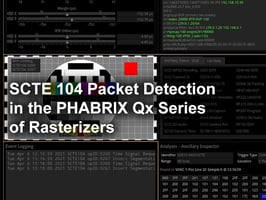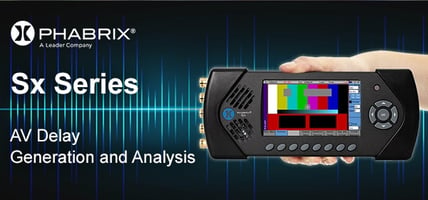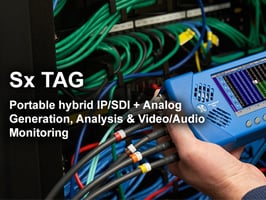SCTE-104 messaging is widely adopted throughout the broadcast industry as the standard method for...
Full Range Analysis – Tell me more!
Following the release of our latest V5.4 software, to support Full Range in the Qx Series of rasterizers and waveform monitors, I’m going to dive a little deeper into what this means for you, our customers.
What is Full Range?
The PHABRIX Qx Series (Qx, QxL and QxP), now supports the detection and analysis of SMPTE Full Range video standards. The units use the definitions for Narrow, Full Protected and Full Range as defined in the recommendations SMPTE RP 2077 Full-Range Image Mapping and EBU R 103 Video Signal Tolerance in Digital Television Systems.
For each RGB or YCbCr color channel in a 10-Bit video signal there are 1024 possible values, from 0 to 1023. Traditionally, 0-100% of all color combinations use only 85% (87.5% for Chroma) of the available digital code values. In the Qx Series, Full Range (FR) allows us to use the whole 100% of digital code values, thus significantly increasing the number of unique colors that we can represent.

So, what does this mean for you?
If you’re a content creator, or if you’re an OTT provider you don’t need to worry about SMPTE Range; you’d rather maximise the image quality of your content. You could use a 12-Bit instead of 10-Bit depth to give you 64 times more unique colors. If you switch to 12-Bit Full Range, however, you can have a massive 100 times more unique color values available compared to the 10-Bit SMPTE range. If you’re providing broadcast content, you can be confident that your Rec.2020 12-Bit Full Range media can be converted to broadcast format and reduced to SMPTE range while preserving as much detail as possible.
In SDI, SMPTE defines code values 0-3 and 1020-1023 (in 10-Bit) as reserved for signalling data. This reservation is a requirement for Full Range as well as Narrow Range, however, in 2110 Full Range, or file-based Full Range there is no such requirement meaning that there IS a difference between SDI Full Range and 2110 or file-based Full Range. However, RP 2077 clearly defines that there is only one definition of Full Range where 0% is 0 and 100% is 1023 (10-Bit) and in SDI, any reserved values should be clipped.
So what does this mean? It means that an SDI SMPTE FR image can only span 4-1019 in code values, or 0.4% - 99.6%, but there is no scaling so 1% black in 2110 FR or file-based FR is still 1% black in SDI SMPTE FR, and similarly 99% white is the same regardless of whether its SDI, 2110 or file-based. The only difference is that a 0.25% black or a 99.75% white in 2110 or file-based FR will get clipped to 0.4% black and 99.6% white in SDI SMPTE FR. If you’re working on 2110 and want to ensure that your Full Range is 100% compatible with SDI then you should be working in SDI Protected Range (Full Protect or FP on the Qx) which enforces the clipping to SDI SMPTE FR in a 2110 environment.

Full Range Analysis
With the different types of Full Range seamlessly integrated in the Qx Series’ Analyzer, the core video analysis toolset now gives you the ability to verify color content regardless of the specific video format being used (SDI, 2022-6 or 2110.) The analyzer configuration tools allow manual configuration of Range within the video standard selection so regardless of whether your Payload Identifier, or SDP are correct or not, it is still possible to analyze Full Range video. In addition, the same analysis toolset can help verify that range conversions within the media chain have been performed correctly.
Full Range Generation
From this software release, our Qx Series can generate video standards in either Full Range (FR), Full Protected (FP) Range, or Narrow Range (NR) in IP 2110, and either Full Range (FR), or Narrow Range (NR) in IP 2022-6 and SDI.
Interested to find out more? Get in touch on the form below to book your Qx Series demonstration!





